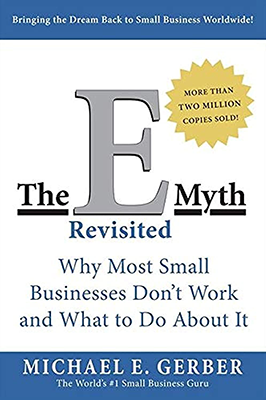The E-Myth Revisited
“The E-Myth Revisited: Why Most Small Businesses Don’t Work and What to Do About It” by Michael E. Gerber is a business book that explores the myths and realities of entrepreneurship, offering practical advice for small business owners. Here’s a summary:
- The E-Myth: The “E” in E-Myth stands for Entrepreneurial Myth, which is the mistaken belief that small businesses are started by entrepreneurs seeking freedom, when in reality they are often started by technicians (people with technical skills) who are skilled at a specific trade or craft.
- The Three Roles of Business Owners: Gerber introduces the concept of the three roles that business owners must fulfill:
– The Technician: The person who performs the technical work of the business.
– The Manager: The person who oversees the day-to-day operations of the business.
– The Entrepreneur: The visionary leader who drives the strategic direction and growth of the business.
- The Fatal Assumption: Gerber identifies the fatal assumption that leads many small business owners to failure: the belief that if you understand the technical work of a business, you understand how to run a business that does that technical work. In reality, running a business requires a different set of skills and a focus on systems and processes.
- The Business Development Process: Gerber outlines a step-by-step process for developing a successful business, including:
– Creating a Primary Aim: Defining the long-term vision and goals of the business.
– Developing a Strategic Objective: Setting specific, measurable goals for the business.
– Organizing the Business: Creating systems and processes to streamline operations and ensure consistency.
– Managing the Business: Implementing management systems to track performance and make informed decisions.
– Growing the Business: Continuously innovating and expanding the business to achieve long-term success.
- The Importance of Systems: Gerber emphasizes the importance of developing systems and processes that allow the business to operate efficiently and consistently. This includes everything from marketing and sales systems to operational and financial systems.
- Working on the Business, Not in It: Gerber encourages business owners to spend more time working on their business rather than getting bogged down in day-to-day operations. This involves focusing on strategic planning, business development, and creating systems that allow the business to run smoothly without constant oversight.
- The Franchise Prototype: Gerber introduces the concept of the franchise prototype, which involves creating a business model that is scalable, replicable, and can be operated by anyone with minimal training. This allows businesses to achieve consistency and quality across multiple locations.
Overall, “The E-Myth Revisited” offers valuable insights and practical advice for small business owners looking to build successful, sustainable businesses. It challenges common misconceptions about entrepreneurship and provides a roadmap for creating systems and processes that drive growth and profitability.

